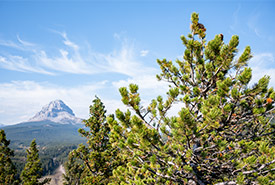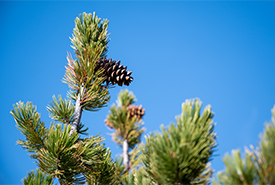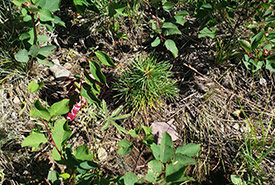Saving limber pine, one cone at a time
Conservationists working to recover limber pine, in partnership with NCC
Limber pine backed by Crowsnest Mountain (Photo by Sean Feagan/NCC staff)
There are many dedicated and passionate people working in conservation, but those who tirelessly climb mountains to save endangered trees might be near the top of the list.
Staff and volunteers with the Whitebark Pine Ecosystem Foundation of Canada have been pulling out all of the stops to save two endangered tree species: whitebark and limber pine.
These trees, found in western North America including in Alberta and British Columbia, are in serious decline. While this is due to several reasons, including climate change and mountain pine beetle, the main culprit driving their demise is white pine blister rust, a fungal pathogen.
One of the main efforts that the foundation is spearheading is finding and propagating trees resistant to this deadly disease.
The Nature Conservancy of Canada (NCC) has partnered with this organization by providing it access to NCC-owned or managed conservation sites along the eastern slopes of the Rocky Mountains, home to stands of limber pine. This species grows at lower elevations than whitebark pine, and so is more likely to be found on the private lands NCC works to conserve.
It is challenging and time-consuming work, explains Jodie Krakowski, vice-present of the Whitebark Pine Ecosystem Foundation of Canada, who also co-chairs Alberta’s recovery team for whitebark and limber pine and chairs the national recovery team as well.
Finding resistance
First, to find resistant trees, they look to where the disease has hit the hardest.
“We look for stands of trees that have high infection rates, like 80 or 90 per cent infection rate. Unfortunately, there are quite a lot of those in Alberta,” says Jodie. “Then we find the healthy trees in those heavily infected stands, which are most likely to be resistant.”
Once suitable limber pine are identified, conservationists visit them again early in the season in a year when the trees are producing seed cones, which happens only every three to five years. They cover the developing cones to protect them from hungry wildlife.

Limber pine cone (Photo by Sean Feagan/NCC staff)
Limber pine produces large, nutritious and energy-rich seeds, which is why they are among the favourite foods of many species, including red squirrel and Clark’s nutcracker, and why the trees are considered keystone species in these foothills ecosystems.
A typical cone has about 75 seeds in it, about half of which produce viable seedlings.
Only time will tell
After the cones have been protected, conservationists then visit the trees again later in the year to collect the fully developed cones.
Once collected, the seeds are sent to a lab, where they are germinated and sewn, to later check if they are indeed resistant. It is no easy task.
“That process takes about seven years, and it costs about $2,000 a tree,” Jodie says. “So, we don’t really know if any of the seeds that we’ve collected from trees on NCC properties yet are resistant, because we just haven’t had the time to complete the process.”

Limber pine seedling (Photo by WPEF)
The trees of tomorrow
The Whitebark Pine Ecosystem Foundation of Canada is also working to plant resistant limber pine seedlings to help boost the tree’s population.
In 2022, NCC natural area managers working along the eastern slopes began planting limber pine seedlings on NCC properties.
“We did a bunch of site visits to look at what sites might be the best candidates,” Jodie says. “Then we planted a bunch of trees, and now we are monitoring them to see how they are faring over time, because they grow super slow.”
The hope is that these trees will help form the limber pine stands of tomorrow, bolstering this incredible imperilled species’ population and providing food and shelter to the species found in the Rocky Mountains.
The Nature Conservancy of Canada is working to ensure these trees have natural spaces on which to grow. To support this mission, consider supporting NCC, such as by donating to our campaign to conserve The Yarrow in southern Alberta.




